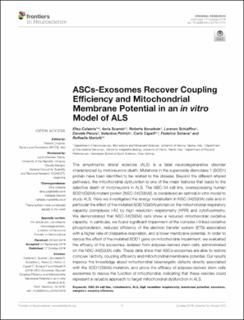| dc.contributor.author | Calabria, Elisa | |
| dc.contributor.author | Scambi, Ilaria | |
| dc.contributor.author | Bonafede, Roberta | |
| dc.contributor.author | Schiaffino, Lorenzo | |
| dc.contributor.author | Peroni, Daniele | |
| dc.contributor.author | Potrich, Valentina | |
| dc.contributor.author | Capelli, Carlo | |
| dc.contributor.author | Schena, Federico | |
| dc.contributor.author | Mariotti, Raffaella | |
| dc.date.accessioned | 2020-05-11T07:00:25Z | |
| dc.date.available | 2020-05-11T07:00:25Z | |
| dc.date.created | 2020-03-20T21:30:10Z | |
| dc.date.issued | 2019 | |
| dc.identifier.citation | Frontiers in Neuroscience. 2019, 13, 1070. | en_US |
| dc.identifier.issn | 1662-4548 | |
| dc.identifier.uri | https://hdl.handle.net/11250/2653759 | |
| dc.description | This is an open-access article distributed under the terms of the Creative Commons Attribution License (CC BY). The use, distribution or reproduction in other forums is permitted, provided the original author(s) and the copyright owner(s) are credited and that the original publication in this journal is cited, in accordance with accepted academic practice. No use, distribution or reproduction is permitted which does not comply with these terms. | en_US |
| dc.description.abstract | The amyotrophic lateral sclerosis (ALS) is a fatal neurodegenerative disorder characterized by motoneurons death. Mutations in the superoxide dismutase 1 (SOD1) protein have been identified to be related to the disease. Beyond the different altered pathways, the mitochondrial dysfunction is one of the major features that leads to the selective death of motoneurons in ALS. The NSC-34 cell line, overexpressing human SOD1(G93A) mutant protein [NSC-34(G93A)], is considered an optimal in vitro model to study ALS. Here we investigated the energy metabolism in NSC-34(G93A) cells and in particular the effect of the mutated SOD1(G93A) protein on the mitochondrial respiratory capacity (complexes I-IV) by high resolution respirometry (HRR) and cytofluorimetry. We demonstrated that NSC-34(G93A) cells show a reduced mitochondrial oxidative capacity. In particular, we found significant impairment of the complex I-linked oxidative phosphorylation, reduced efficiency of the electron transfer system (ETS) associated with a higher rate of dissipative respiration, and a lower membrane potential. In order to rescue the effect of the mutated SOD1 gene on mitochondria impairment, we evaluated the efficacy of the exosomes, isolated from adipose-derived stem cells, administrated on the NSC-34(G93A) cells. These data show that ASCs-exosomes are able to restore complex I activity, coupling efficiency and mitochondrial membrane potential. Our results improve the knowledge about mitochondrial bioenergetic defects directly associated with the SOD1(G93A) mutation, and prove the efficacy of adipose-derived stem cells exosomes to rescue the function of mitochondria, indicating that these vesicles could represent a valuable approach to target mitochondrial dysfunction in ALS. | en_US |
| dc.language.iso | eng | en_US |
| dc.subject | NSC-34 cell line | en_US |
| dc.subject | mitochondria | en_US |
| dc.subject | ALS | en_US |
| dc.subject | high resolution respirometry | en_US |
| dc.subject | membrane potential | en_US |
| dc.subject | exosomes | en_US |
| dc.subject | complex I | en_US |
| dc.subject | coupling efficiency | en_US |
| dc.title | Ascs-exosomes recover coupling efficiency and mitochondrial membrane potential in an in vitro model of als | en_US |
| dc.type | Peer reviewed | en_US |
| dc.type | Journal article | en_US |
| dc.description.version | publishedVersion | en_US |
| dc.rights.holder | © 2019 Calabria, Scambi, Bonafede, Schiaffino, Peroni, Potrich, Capelli, Schena and Mariotti. | en_US |
| dc.source.pagenumber | 1-13 | en_US |
| dc.source.volume | 13 | en_US |
| dc.source.journal | Frontiers in Neuroscience | en_US |
| dc.identifier.doi | 10.3389/fnins.2019.01070 | |
| dc.identifier.cristin | 1802749 | |
| dc.description.localcode | Seksjon for fysisk prestasjonsevne / Department of Physical Perfomances | en_US |
| cristin.ispublished | true | |
| cristin.fulltext | original | |
| cristin.qualitycode | 1 | |
